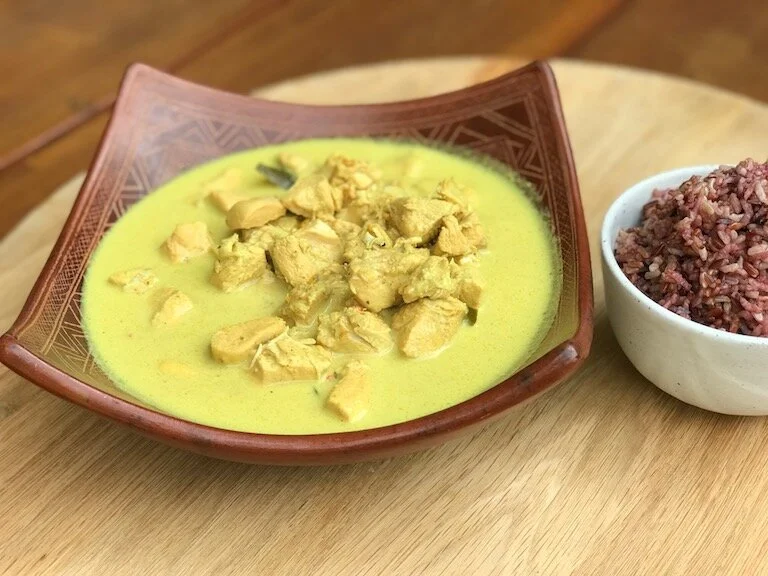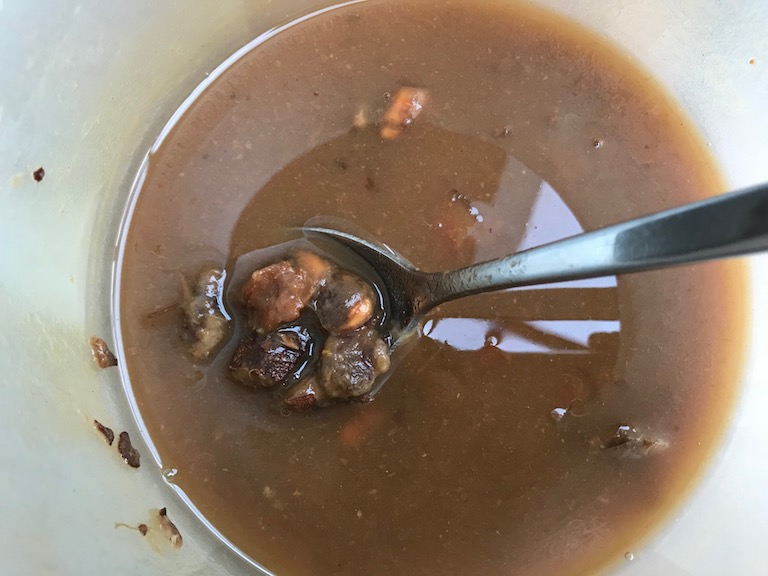How to Make Gulai-style Padang Chicken Curry
Today in the ajb Kitchen we are making Gulai Ayam (Curry Chicken). Originating in Indonesia’s western most island of Sumatra, specifically the province of Western Sumatra, Gulai Ayam is a regular dish in Padang restaurants throughout the Indonesian archipelago. Richer and more complex in flavour than Kari Ayam, Gulai Ayam resembles an Indian-style curry due to the numerous spices required to prepare the curry paste (bumbu basah).
Padang food is also known as Minang food as it is the cuisine of the Minangkabau people of Western Sumatra. In this photo, a serve of Gulai Ayam is sitting beneath the King Prawn dish (top left)
Gulai Ayam, unlike the more mild Kari Ayam can be particularly hot due to the addition of generous amounts of chilli. In Padang, being considered a proficient cook is determined by one’s ability to prepare Gulai.
Served with steamed rice and condiments such as sambal and some crunchy krupuk, this recipe is the perfect dish to make for family and friends. I also like to include a side serve of stir-fried snake beans.
Just one piece of advice before I wish you well in the kitchen: Double the recipe for the spice paste. You can use half of it to cook a meal now and the other half can be stored in your fridge for use in the near future.
Selamat memasak!
Happy Cooking!
Jo :)
Ingredients
To make the spice paste -
5 shallots halved
4 cloves garlic peeled
3 cm length of fresh ginger (peeled and chopped)
2 cm length of fresh tumeric (peeled and chopped)
3 tsp coriander powder
Chopped and seeded chilli (to taste)
2 tsp ground cumin
1/2 tsp ground nutmeg
2 - 3 Tb vegetable oil
The ingredients to make Gulai paste (along with a slurp of vegetable oil to bind all ingredients)
To cook the chicken -
2 lengths of lemongrass (outer skin removed and bruised to release flavour
2 cinnamon quills
4 kaffir lime leaves (torn to release aroma)
2 Indonesian bay leaves (daun salam)
2 cups fresh water (approximately)
2 cups coconut milk
Salt to taste
Pepper to taste
Palm sugar to taste
2 Tb lemon juice
3 - 4 Tb vegetable oil
1 kilogram chicken pieces (thigh or breast - skin off)
2 Tb tamarind water (*See Cook’s Notes for how to make tamarind water)
Getting ready to cook the chicken - A few tablespoons of Gulai paste, some vegetable oil, two lengths of lemongrass and a couple of quills of cinnamon
Clockwise - Tamarind (ready to be made into tamarind water), coconut milk, water, salt, pepper & palm sugar and some dried kaffir lime leaves
Indonesian bay leaves, 'daun salam'
Method
Coat chicken pieces in lemon juice and set aside.
Into a food processor place ginger, shallots, garlic, turmeric, ground coriander, chillies, ground cumin, nutmeg and 2 Tb vegetable oil. Pulse until a smooth paste is formed.
Into the food processor
Fresh and fragrant Gulai paste
Turn on cooktop to a medium heat. Add vegetable oil to a deep heavy-based frypan/ or a large heavy-based saucepan and heat. Add bumbu (spice paste) and sauté until fragrant.
Fry until fragrant (take care not to burn)
Add chicken pieces to pan tossing until coated in curry paste. Continue to sauté until chicken is sealed.
Add sticks of lemongrass and cinnamon quills as well as chopped kaffir lime leaves, Indonesian bay leaves, water, coconut milk, a pinch or two of salt, a tablespoon of palm sugar, the tamarind water and a few turns of the pepper mill.
Ensure liquid level is just above chicken pieces. If necessary, top up with water.
Cover with lid and bring to a gentle boil, stirring regularly to ensure chicken does not stick to the bottom of the pan.
Once a gentle boil has been achieved, remove lid, reduce the heat to a simmer and continue cooking until the chicken is tender and the sauce has thickened. Taste once more and adjust flavour with additional seasonings.
Serve with steamed rice and any condiments of your choice (some ideas include sambal and stir-fried snake beans ‘kacang panjang’).
Cook’s Notes
The first time you make this recipe, you may wish to add a little less chilli until you establish your optimum chilli threshold.
Don’t forget to double the recipe and store the Gulai paste in an airtight container in your refrigerator for up to one week.
Substitute tofu and/or tempeh for a vegetarian version of this dish.
Like soups and stews, this curry tastes even better when it has rested overnight allowing the flavours to infuse. Why not make an extra large pot of Gulai Ayam and pop some of it in the freezer.
How to make tamarind water: Dissolve 2 Tb of tamarind paste in about 12 Tb of boiling water. Using a spoon, stir to separate tamarind from its seeds and to encourage the paste to dissolve into the water. Strain to separate tamarind water from fibrous material and seeds. Store in a jar in the refrigerator.
Unprocessed tamarind - you can purchase this from your local Indonesian pasar or supermarket
Dissolving tamarind in boiling water
Straining tamarind water to separate it from its seeds and fibrous material
Tamarind water - ready for your Gulai
So, what did you think of today's recipe? We're absolutely certain you will love our Gulai Ayam. It's a hit in our household and beats any store-bought curry paste.
To help you continue on your Indonesian-inspired cooking journey, here are a few more posts we know you’ll enjoy making:
Red curry prawns Indonesian-style
Indonesian style Roast Chicken
How to make spicy Beef Rendang
How to make tasty Gado Gado
Words: Jo Stevens Photography: a journey bespoke





















